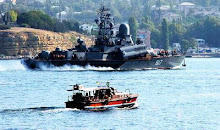A perfect place, at the very crossroads of nations and civilizations, not to mention a nice harbor, Sevastopol has always been and will forever be a golden getaway and a permanent battlefield. It all began with Chersonesos in the early 6th century BC when settlers of Greek Heraclea Pontica founded a colony in the south of the Crimean peninsula. The place later grew into a major trade point and constant source of discord between Scythians and Greeks (superseded by Romans), and later by Russians and Byzantines, Turks, as well as European allies and Germans.
The remains of renown Chersonesos can still be visited on the outskirts of Sevastopol. Those interested in antiquity will be surprised to see majestic columns of Greek temples and a Roman amphitheatre with numerous remains of foundations of large homes.
The locals come to bathe in proximity to the ruins, considering the pebbly beach one of the best in the area. A moderate fee is required to visit the territory, but locals just climb over a 16th century wall, arguing "we bathed, bathe and will continue to bathe like our grandparents did." The combative instinct has been nurtured by centuries of bloody wars and siegesl.
Another Chersonesos landmark is the newly rebuilt St. Vladimir Cathedral that overlooks the place. It is named after Saint Kiev Prince Vladimir who fought much in the region and eventually Christianized the Russian state.
Sevastopol itself was founded in 1783, after the Crimea was annexed by Russia, as a fortress and a convenient port with a row of harbors. Paying its respects to the region'slong history, Catherine the Great had the city's name based on two Greek words: Sebastos ("venerable") and Polis ("city") which evolved into ‘Sevastopol' over the years. The town's glorious military history did not remain idle for long. In 1854-1855, Sevastopol survived through its first big siege carried out mainly by the British, French, Sardinian and Turkish troops. Russian sailors had to sink an entire fleet to block the entrance to the harbor. Today, the column of the Sunken Ships Monument rises in the harbor near Primorsky boulevard (Marine boulevard).
The Heroic Sevastopol Defense museum is still one of the most visited places in the city. A century ago, Sevastopol faced another great siege by Germans that lasted 250 days in 1941-1942. The peculiar fact is that Germans cut off water supplies but did not take into account the big wineries of the city that were distributed among the population and used for food preparation and washing-up and of course drink.
The whole city seems to be military to the bone with every stone, every street and every building somehow proud of being part of a glorious history. The mere names of the streets remind of great Russian sailors and admirals. Being a military base and a former closed Soviet city, Sevastopol maintains its popularity among tourists as a southern seaside resort with picturesque landscape and seaside leisure.
The pleasant thing about the city is that it does not feel like a tourist theme park, thus, you can calmly stroll along its peaceful streets with no annoying taxi drivers and tourist kitsch sellers (although you can find them if you like).
Stroll along the city's main boulevards between Artillery and Southern bays. Take a boat excursion in the Artillery bay to sail along the main coastal landmarks and have a unique experience of passing near all the military ships and facilities of the Black Sea Fleet (both Russian and Ukrainian).
Following that it is recommended to go up one of the main streets of Sevastopol. There is no need to be a genius to find Lenina Ulitsa and its overlook along the Southern bay.
The calm and secure bay is packed with grey and seemingly narrow warships producing a strong impression of sardine tins. Note the small railway station and the railway track that stretches along the shore and pierces the hills. This is considered one of the most complicated railroad tracks in Europe. Walk back downtown in a calm and meditative manner, occasionally plunging into side streets and coming across cozy nooks wallowing in greenery. Most of the city was built anew after World War 2 in a modest Soviet post-war style, but exceptions of magnificent Art Nouveau buildings do occur and are anyway related to military history and Russian Navy. Although the city is a separate subject of Ukraine many Russian banners and St.Andrew crosses (symbol of Russian navy) can be seen in the streets.
Take a ferry to the northern part of the city crossing the large bay harbor dividing the city into two uneven parts and enjoy the panorama of the city, the Pride of Russian Sailors, as the official anthem of the city still states despite all Ukrainization attempts
The best time to visit Sevastopol is at the end of July. The last weekend of this month is usually marked by a Russian Navy holiday with ship parades, fireworks and other festivities. The city can be reached by regular direct trains or by regular flights through Simferopol (an hour drive from the city).
Another interesting place to see is Balaklava, a former top-secret town with a nuclear submarine base (now open for the public), an ancient Genoese fortress on the top of a hill and numerous World War II facilities still intact. To the north of Balaklava is the so called Valley of Death, where an English elite cavalry brigade led by Lord Cardigan found their final abode in a massacre of the Crimean War in 1854. A monument to the English cavalrymen with cemetery is still preserved. In 1945, it was visited by Winston Churchill. And nearby Bakhtiseray, the remains of the Khanate and historical site of the crimeajewel.
Subscribe to:
Post Comments (Atom)









No comments:
Post a Comment